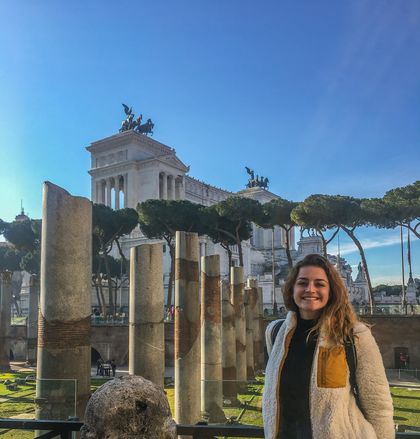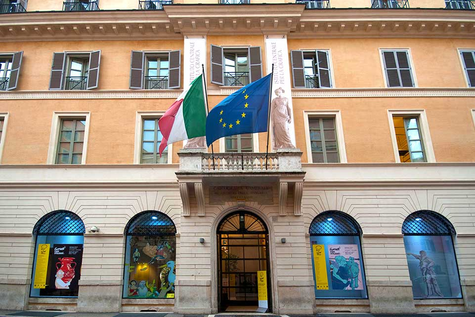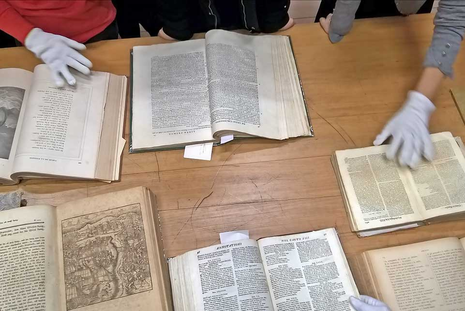Connected to Rome: Spring 2020 student continues internship virtually

Margaret (Maggie) Dosch ‘21, originally from South Bend, Indiana, is an art history and Italian studies major with a minor in studio art. During the spring 2020 semester, she served as the student minister at the Rome Global Gateway (RGG), leading faith-based initiatives and activities. Back on campus, she is an art history club officer, a member of the Italian club (Circolo Italiano), a member of Right to Life Club (and several subcommittees), a Snite student programming committee volunteer, a Snite Museum Gallery teacher, and Breen-Phillip's Hall spirituality & fellowship commissioner.
Even during the time of COVID-19, internships allow students to immerse themselves even further into the unique cultural and academic worlds of Rome. Months before each semester begins, the Rome Global Gateway faculty and staff review incoming Rome International Scholar student applications and profiles and work together to create a custom-built curriculum that aligns with each student’s interests, curiosities, and academic background.
“Sometimes we can find a librarian, a scholar, or another kind of connection that can help advance a student’s project and enrich his or her experience here. We do everything we can to make as many connections for them as possible,” explains Academic Director Heather Hyde Minor.
Thus, each new Rome International Scholar gives faculty and staff the opportunity to enrich and extend the RGG collaborative network. Last winter, after reviewing spring 2020 student Maggie Dosch’s profile, including her background and interests in art history and Italian language, Hyde Minor knew the perfect organization to reach out to, Istituto Centrale per la Grafica (also referred to as the Institute). Based in the heart of Rome just steps from the Trevi Fountain, Istituto Centrale per la Grafica, was created “to preserve, protect, and promote a heritage of works that document graphic art in its different types.” The Institute functions as a museum, library, research center, and educational service.

Timing was perfect. Hyde Minor, having collaborated with Istituto Centrale per la Grafica since she was a graduate student, had recently learned that they were organizing a new internship program. And thus, with the support of Mallory Nardin and the administration of Istituto Centrale per la Grafica, the RGG gained a new internship partner.
In January 2020, Dosch took her first transcontinental flight to Rome to join the Rome International Scholars Program.
When asked why she chose to apply for the program, Dosch reflects, “I liked the idea of really challenging myself.”
“I was definitely scared a bit at first, but the idea of going to Rome, living with a host family, immersing myself in the language, and completing research for the first time, was out of my comfort zone. But, it was a challenge I really wanted to take. And, being an Art History major with an internship in Rome, that’s just a dream come true”, says Dosch.
During her time in Rome, Dosch went to the Institute several times each week to support archival, organization, and research activities. One specific project consisted of inventorying artifacts and books for a new display.
“It’s a bit nerdy, but working on that was so ‘art history cool’. I had the chance to see so much of their collection, books, and catalogues,” she says.
Not only was Dosch able to advance her experience in the field of art history, but through the unique opportunity of working alongside a Roman peer, Sara, another student intern from a local university, Dosch’s language confidence and skills improved vastly. The two continue to stay in touch even after Dosch’s return to the United States.
“It’s so nice,” says Dosch. “Sara and I will call and text and update each other. She tells me about the situation in Rome and I share what’s happening here. It’s also a great way for me to keep up with my Italian.”
When the COVID-19 crisis escalated and RGG students were sent back to the United States, Dosch was able to continue her internship at Istituto Centrale per la Grafica through virtual means. She communicates with her supervisor, Gabriella Bocconi, via email and has been working on entirely new projects and tasks. Though she’s back in the United States, most of her communication and work is in Italian, allowing Dosch to continue her progress from her time in Rome.
“She’s an ideal Rome International Scholar,” comments Hyde Minor. “ Maggie is always so full of ideas and enthusiasm and just so engaged in everything that’s going on around her. That’s what this program was created for, to foster the growth of these students who are seeking deeper and richer experiences during their time in Rome and beyond.”
The Institute has been using this unique time to increase opportunities for engagement through the website, social media, and online events.
“This was a time of digital revolution for the Institute,” Dosch says.
Dosch’s new projects consisted of creating content for the new Facebook page, supporting Italian-English translations for various events and projects, and creating a database of possible organizations in the United States for future collaborations.
“It was one of the most unexpected but wonderful parts of my experience to have a connection to Rome once I had returned home. I’m very glad that they were so open to allowing my internship to continue,” says Dosch.
Her internship with Istituto Centrale per la Grafica has given Dosch even more confidence that she’s heading in the right direction.

“Professionally, I now have the confirmation that I would love to work in a museum or art institute,” she says. “It was always my dream but working with the Institute was my first taste of the big picture of what a role like this could look like.”
From a personal perspective, Dosch’s internship gave her confidence in stepping out of her comfort zone, testing her language skills, and adapting to new situations and challenges.
“Now I know that if I wanted to come back one day and work at an Italian organization, I would be able to,” says Dosch.
Dosch hopes to return to Rome one day to continue exploring the art, history, culture, and language of the Italian capital and looks forward to beginning her final year at the University of Notre Dame next fall. Like many Rome International Scholars, this experience has become a stepping stone for her as she continues to explore opportunities ahead. When reflecting on her experiences, she cites Rome International Scholars as “one of the most life-changing communities I’ve been a part of, not only at Notre Dame, but in all of my life experience.”
Hyde-Minor says Rome International Scholars are truly unique in their academic strengths, curiosity about the world, and a desire to take the experience that they have here Rome and use it to shape their lives.
“What happens to them next is really tremendous,” says Hyde Minor.